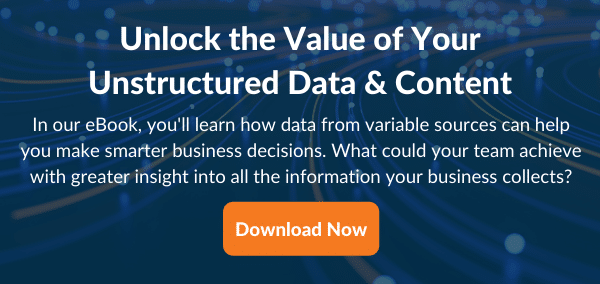The Current State of Unstructured Data Analysis and What It Means for Your Business
UPDATED February 9, 2023: The data analytics industry is continually evolving. What seemed like science fiction only years ago has become a business fact as new data analyzing tools and techniques come to market. And while larger organizations (with deeper pockets) have been the driving force of much of this change, advancements in artificial intelligence and machine learning have democratized big data analysis. Nowhere is this more apparent than the evolution of the modern, unstructured data analysis landscape.
Accounting for nearly 80% of all data generated and stored by an organization and growing at a rate of 55%-65% each year, unstructured data is one of the largest untapped and continuous sources of business intelligence. We’ve put this blog post together as an introduction to unstructured data and some of the tools and techniques that companies are using to analyze and mime their unstructured data for actionable insights to improve their organization and bottom line.
Understanding the 3 Different Types of Big Data
To understand what is meant by the term unstructured data, you first need to know where it falls within the broadest categories of business data – structured data, semi-structured data, and unstructured data. The below table compares the overarching differences between these data sets.
| Structured Data | Semi-Structured Data | Unstructured Data |
|
|
|
|
|
|
|
|
|
As you can see, the definition of unstructured data is broad. There is no consistent medium or format, but most unstructured data is unstructured text: documents, social media posts, emails, surveys, and more.
So, how does a large organization mine swathes of unstructured data for nuggets of actionable gold?
The Current Environment and Capabilities for Mining Unstructured Data
As the importance of mining unstructured data grows, new discovery and intelligence tools are introduced to the market. Simultaneously, as analysis technology improves, more companies build systems and tools that have integrated data logging capabilities, capturing and generating more unstructured data than in previous years.
This means that not only do companies of all sizes have access to more advanced data mining tools, they also have more extensive data sets to analyze.
In general, there are three core AI capabilities that are empowering unstructured data analysis:
Intelligent Document Processing*: Fueled by natural language processing (NLP) and machine learning (ML), these systems analyze text-based documentation (PDFs, notes, reports) to uncover insights. The machine-learning capabilities allow you to “teach” the AI how to read your specific documentation and guide its insight discovery.
Computer Vision: This is used to analyze image and video content through digital imaging technologies, pattern recognition, and ML in order to process your visual data and uncover actionable intelligence.
Internet of Things: Here, data is generated from machines. AI relies on real-time analytics, ML, and smart systems to analyze the data for performance-improvement insight.
Intelligent Document Processing and Text-Based Data Analysis
We stated this earlier, but the vast majority of an organization’s unstructured data is text-based. More organizations are leveraging the power of Intelligent Document Processing (IDP) systems to drive data mining and identify impactful findings.
Here are just a few examples of how companies are leveraging document understanding to fuel insight gathering:
- – Sentiment Analysis: Automatically classify text by sentiment and pull together trend reports.
- – Keyword Extraction: What keywords are recurring throughout a data set?
- – Regulatory and Compliance Support: Identify regulatory or compliance issues before they impact your business.
Getting Started with Unstructured Data Analysis
Ready to get started mining your unstructured data? TekStream has deep experience deploying both pre-built and custom unstructured data analysis solutions that empower teams with the insights they need to take action and improve their bottom line. Read more about IDP, and contact us to learn more about how we can assist your company with its unstructured data analysis goals.
Are you looking for more insights and best practices for unlocking value from your unstructured data? Download our free eBook, “How Cloud AI Unlocks Value from Unstructured Data and Content.”

*Intelligent Document Processing may also be referred to as Document Understanding.

